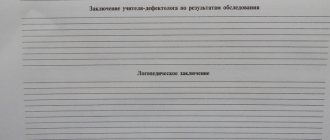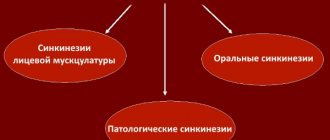Why does deviation develop?
Incorrect pronunciation of certain sounds is a problem that can be both social and biological in nature. In the first case, the little patient simply hears adults speaking incorrectly and tries to imitate them, copying the accent, placing accents incorrectly, or distorting words. At the same time, the child does not realize that he is speaking incorrectly and considers this to be the norm. Speech deviations can develop in cases of pedagogical neglect, when no one works with children, and also, on the contrary, due to too intense classes. There are often cases when the mechanism of speech therapy work with functional dyslalia slips only because the young patient is bilingual, that is, he speaks two languages with equal success, but at the same time he can confuse phonemes or pronounce them incorrectly. Biological factors include a general weakening of the body that occurs against the background of frequent illnesses, as well as minimal brain dysfunction.
Directions for speech therapy work for alalia
Corrective work when identifying pathology should be carried out using a set of methods: drug therapy, psychological and pedagogical intervention. The goal of pharmacotherapy is to stimulate the maturation of brain areas responsible for speech function. Speech therapy massage, laser and magnetic therapy, electrophoresis, and hydrotherapy are used as additional methods of drug treatment.
Alalia is systemic in nature, so the impact should be on all areas of the body. During speech therapy classes, the child’s socialization skills are stimulated, active and passive vocabulary is formed, coherent and meaningful speech develops, and sound pronunciation is corrected.
Children diagnosed with alalia receive help in specialized preschool institutions and correctional centers. The prescription of a treatment regimen should occur purely individually, depending on the characteristics of the course of the disease.
Diagnosis of deviation
Speech therapy work for dyslalia must take into account many factors. For example, it is important how the expectant mother’s pregnancy progressed and whether the baby suffered psychological trauma in early childhood. Specialists examine the child’s speech apparatus to exclude possible pathologies and perform a comprehensive diagnosis of the body, thanks to which the causes of the disorder can be accurately identified. It is also important to determine the form of pathology, which is qualified by a number of characteristics and can be:
- Monoamorphous - 1 to 4 sounds are pronounced incorrectly.
- Polyamorphous - more than 4 sounds are pronounced incorrectly.
Our Center’s specialists also determine which groups of phonemes the patient distorts and identify possible deviations associated with the replacement of paired, voiceless and voiced consonants. The preparatory stage of speech therapy work for dyslalia can take quite a lot of time, since the specialist needs to identify all the nuances and deviations in the patient’s speech in order to draw up a competent speech correction plan. The system of correctional and speech therapy work for dyslalia is developed individually, taking into account the developmental characteristics of the baby.
Objectives of speech therapy work for alalia
Systematic work on speech and mental skills is aimed at accelerating the development of brain areas responsible for these functions. Mandatory conditions for achieving progress are:
- Early diagnosis and initiation of treatment. The optimal age for starting therapy is considered to be 3-4 years. But if the disease manifests itself earlier, there is no point in waiting for this age; treatment should begin immediately.
- Favorable external conditions for the treatment of pathology. Ensuring a proper and friendly atmosphere in the family is the primary task of parents. Often the cause of alalia is the child’s environment and socialization. The slightest inattention and neglect can lead to thoughts that something is wrong with him. You should not focus on inferiority; it is better to refrain from discussing the problem in the presence of the child.
- Ensuring that the child communicates with younger friends who do not have speech problems returns the patient to an early stage of development and helps eliminate the psychological barrier.
- Consistent approach to therapy. Treatment should begin with the formation of simple skills, gradually complicating the tasks.
- A playful and everyday form of presenting treatment methods. You should not impose activities on your child that cause him a negative reaction. It is advisable to develop speech skills in everyday life and games, stimulating the need for communication and socialization.
At first, it is important to overcome the child’s negative attitude towards the specialist and get rid of the fear of classes. This task is achieved through emotional play situations in which the baby is quite easy to involve.
Ways to get rid of speech impediments
With dyslalia, the work of a speech therapist begins with diagnosing and eliminating problems that may prevent the child from correctly pronouncing individual letters. For example, sometimes there is a need to eliminate malocclusion or correct pathology of the palate or teeth. When mechanical obstacles are eliminated, a few lessons may be enough for the child to learn to pronounce certain phonemes correctly. The correction is performed in a playful manner and does not cause discomfort to the baby.
The direction of speech therapy work for organic dyslalia is determined by the type of pathology, the emphasis is on the correct pronunciation of individual sounds. At the same time, the stages of speech therapy treatment for dyslilili are determined based on the form of the pathology: teaching a child to correctly pronounce 1–2 phonemes is much easier than correcting 5–6 sounds.
Principles of speech therapy work for dyslalia:
- Principle of accounting for leading activities. Classes must be organized in a form that is interesting to the child: in the form of a game, with elements of competition among schoolchildren.
- Development principle. Speech therapy classes should not only eliminate incorrect sound pronunciation, but also stimulate the child’s cognitive activity, which will contribute to his development.
- Ontogenetic principle. The sequence of appearance of sounds in ontogenesis is taken into account when overcoming polymorphic dyslalia.
- The principle of a person-oriented approach. See the child as an individual and adhere to a partnership style of communication. Create an emotionally favorable atmosphere. Let him feel that he will cope with the proposed task.
- The principle of changing different types of activities (techniques) during the lesson. Fatigue must be avoided.
- The principle of using all analyzers. In addition to acoustic supports, the child uses visual, tactile and muscle sensations.
- The principle of visibility. Visual and didactic material must be used.
- Didactic principle from simple to complex.
The purpose of speech therapy: the formation of skills and abilities to correctly reproduce speech sounds.
Stages of speech therapy intervention:
- Preparatory stage.
- The stage of formation of primary pronunciation skills.
- Stage of formation of communication skills.
Preparatory stage.
The goal is to include the child in the speech therapy process.
Tasks:
- Creating a lesson plan. Adapt to the speech therapy room, to yourself.
- Formation of voluntary forms of activity and a conscious attitude towards classes. The child must get used to a certain form of classes, to the need to follow the instructions of the speech therapist.
- Development of mental functions: voluntary attention, memory, thinking (analytical operations, comparison and inference operations).
- Development of phonemic awareness.
- Formation of articulatory skills.
Development of phonemic awareness.
At the preparatory stage, work is carried out to develop auditory attention and memory. The main methodological condition is that the child should not utter a defective sound! It is necessary to work on understanding spatial relationships (up, down, at the beginning, at the end, after, before). This is preparation for mastering phonemic analysis skills. Formation of articulatory skills.
The task is to master the totality of all articulatory movements and, above all, to achieve high-quality performance. Accuracy, clarity, normal pace, sufficient volume, coordination, ability to hold a given pose. Articulation is a set of movements and positions of the speech organs - lips, tongue, necessary for the formation of sounds characteristic of a particular language. The development of correct articulation of a disturbed sound is possible in the presence of well-formed articulatory motor skills, i.e. the ability to control the organs of speech and speech breathing.
It is necessary to learn to tense and relax the tongue, hold it in the desired position, direct the air stream in the right direction, and coordinate the coordinated work of various organs of articulation. This purpose is served by articulatory gymnastics - a set of special exercises for the lips and tongue. Articulatory gymnastics is designed to develop in a fun way the child’s ability to control his own speech organs: tongue, lips, lower jaw and speech breathing.
Requirements for performing articulatory exercises:
- Performing articulatory gymnastics must be mandatory and regular during the period of preparing articulatory structure and sound production.
- An important requirement is volition and awareness at the age of 5-6 years. It is necessary to teach the child to control the correct execution of articulatory exercises. First, they are performed according to the model in front of a mirror. You can help with a spatula or probe. Articulation is considered mastered if it is performed by the child accurately at the request of the speech therapist without visual control based on kinesthetic sensations.
- Important methodological note! Don't mention the sound that is being worked on. An articulatory pattern is created, the speech therapist asks to blow. You can't say: say "SSSS".
- With dyslalia, the child is not loaded with a variety of articulatory exercises; only those that are necessary to produce defective sounds are selected.
- The system of exercises should include both dynamic (for the development of mobility, the child learns to realize that the lips and tongue move and can take different positions) and static (the ability to hold a pose for a long time and, accordingly, not to lose it during automation) exercises.
- Exercises are needed to combine movements of the tongue and lips, because... when spoken, these organs interact.
- Exercises are performed at a moderate pace with mandatory visual control. It is advisable that both the child and the adult can be in front of the mirror: the adult shows a sample of the exercise, the child repeats after him.
- The exercises are carried out briefly, with a break for another type of work (finger motor skills, mental functions).
- The exercises are given game names: “Swing”, “Horse”. The movements of the tip of the tongue and lips in the baby’s imagination can be associated with already familiar images, developing his imagination and emotional sphere, and turning difficult work into an exciting educational moment.
- Pay attention to the formation of kinesthetic sensations, kinesthetic analysis and ideas.
- When movements for one sound are formed, movements for the next sound begin to be practiced.
The stage of formation of primary pronunciation skills.
The goal is to develop in the child the initial skills of correctly pronouncing sounds.
Work is also being carried out in two directions:
- development of phonemic awareness;
- education of correct sound pronunciation.
Development of phonemic awareness.
As soon as the child has learned to pronounce a sound, work begins on teaching the skills of phonemic analysis and synthesis:
- Isolating a given consonant sound from a number of other sounds.
- Isolating a given consonant sound from the background of a word.
- Determining the position of a sound in a word (beginning, middle, end).
- Analysis and synthesis of the reverse syllable type [ac].
- Analysis and synthesis of a direct syllable like [sa].
- Determination of neighboring sounds.
- Determining the number of sounds in a word.
- Complete sound-syllable analysis and synthesis of monosyllabic words from three sounds such as catfish and two-syllable words such as teeth, based on diagrams where syllables and sounds are designated.
- Complete sound-syllable analysis and synthesis of words with consonant clusters in monosyllabic words like table, chair, two-syllable words with a closed syllable like cat, three-syllable words like panama, the pronunciation of which does not differ from the spelling. In order to teach how to distinguish a normalized pronunciation of a sound from an unstandardized one, after setting the sound and fixing its pronunciation in words, conduct exercises to compare the new and old sound.
Education of correct sound pronunciation.
At this stage, speech therapy work is carried out in the following sequence:
- Sound production.
- Sound automation.
- Differentiation of mixed sounds.
Sound production.
Sound production is the process of forming articulation, teaching a child to pronounce a sound in an isolated sound. Much attention is paid to the development of speech motor skills (the kinetic and kinesthetic basis of articulatory movements). Work continues to consolidate speech breathing skills, develop the voice, and articulatory movements. The development of articulatory motor skills is carried out in the form of articulatory gymnastics - a set of exercises for the lips and tongue, preparing the correct pronunciation of sounds. For each sound, a specific system of articulatory exercises is recommended. Articulatory gymnastics is usually carried out by imitation, in front of a mirror. Movements of the organs of articulation must be accurate, smooth, without accompanying movements, performed with normal muscle tone, without excessive tension and lethargy.
There are 3 ways to produce sound:
- By imitation - based on the auditory image, on the visual perception of articulation. This is due to the fact that children have fairly well developed imitation. However, by imitation, most often it is possible to create a sound only when it is missing. With the help of articulatory exercises, the child is led to create the necessary structure. For example, “cup” for the sound “Ш”. The speech therapist asks you to cup behind your upper teeth and blow.
- Mechanical method of placement using auxiliary means (spatula, probe). With mechanical assistance, the articulatory organs are given a certain position. After long training, he takes the necessary position without mechanical assistance, helping himself with a spatula or finger.
- Mixed method. The previous two are combined. The first method is leading, the second is used as a complementary method. With this method, the child is more active and quickly remembers the necessary routine.
Sound automation.
Automating sound means introducing it into syllables, words, sentences, and coherent speech.
Automation of the supplied sound must be carried out in a strict sequence:
- automation of sound in syllables (direct, reverse, with a combination of consonants);
- automation of sound in words (at the beginning of the word, middle, end);
- automation of sound in sentences;
- automation of sound in tongue twisters, tongue twisters and poetry;
- automation of sound in short and then long stories;
- automation of sound in spoken language.
First of all, the inclusion of sound in syllables is carried out. Didactic material should not contain mixed sounds! To automate sound, they use the techniques of reflected repetition, independent naming of words from a picture, and reading of words. Useful tasks that direct the child to search for words containing a given sound (inventing words with a given sound). You should not limit yourself to just training sounds in words; you need to introduce creative exercises, games, and move from pronouncing individual words to constructing phrases with them and short statements. In the process of automating sounds, work is carried out on the prosodic side of speech: on stress when automating sounds in syllables and words, on logical stress in the process of automating sounds in sentences, on intonation when fixing the pronunciation of sounds in a sentence, connected speech. Along with the development of the phonetic-phonemic side of speech, at the stage of automation of sounds, the vocabulary is enriched, systematized, and the grammatical structure of speech is formed.
Differentiation of sounds.
Work is being done to distinguish the delivered sound from others that were previously mixed. The main task is to develop in the child a strong skill in the appropriate use of the newly learned sound in speech, without mixing it with acoustically or articulatory similar sounds. The transition to the stage of sound differentiation can begin only when both mixed sounds can be correctly pronounced in any sound combination, that is, when the ability to correctly pronounce the “new” sound is already sufficiently automated. The complexity of the speech material here also increases gradually. First, the syllables SA-SHA, AS-ASH, STO-SHTO, which should be pronounced by the child without any sound substitutions, the words - SANKY - HAT, BOWL - BEAR, sentences (such as the widely known SASHA WALKED ON THE HIGHWAY AND SUCKED A DRYER); coherent texts that include both mixed sounds. For preschoolers, special work is needed to prevent such substitutions. Both differentiated sounds are necessarily immediately associated with letters.
Types of jobs:
- What sound do you hear in this word - Ш or С.
- Saying words in pairs. But immediately include it in a minimal context.
- Select pictures on S and W. Important requirement. In one lesson, only one pair of sounds is differentiated. Lessons can be from two to five. Sequence: S - W, S - W, S - S, S - C.
Taking into account the relationship of sounds when choosing the sequence of their production in complex dyslalia.
The didactic principle of consistent transition from simple to complex is observed. It is easier to correct pronunciation defects in whistling words than in hissing ones. That's why we start with them. Accordingly, first “L”, then “R”. In this case, it is not only possible, but also necessary to work on two sounds in parallel. However, you should not take sounds whose articulation is opposite. C - L. Mutual inhibition of movements may occur. You should not use sounds that cause the greatest energy consumption. R - W. Great tension in the respiratory organs can lead to rapid fatigue and even dizziness. When working with paired sounds, a deaf sound is placed, then a voice is added.
Stage of formation of communication skills.
The goal is to develop the child’s skills and abilities without the erroneous use of speech sounds in all communication situations. Contents: Completion of work on automation and differentiation of sounds. Consolidating pronunciation skills in various communication situations. Prevention and overcoming reading and writing disorders at the age of 6 - 7 years. Mainly text material is used. Various forms and types of speech are used, creative exercises are used, and material rich in given sounds is selected. Compliance with exactly this sequence in work is mandatory, since any violation of it negatively affects the overall result and delays the work itself.
Dyslalia (sound pronunciation problems)
In NeuroLogopedics, specialists, in addition to traditional staging, massage and universal probes, use vibration massagers Z-Vibe®, DnZ-Vibe®, Z-Grabber™, ARK Animal Menagerie in their work.
The principle of operation of Z-Vibe is to influence (the tongue, the inner and outer surfaces of the cheeks, forehead, cheeks, chin) a person with high-frequency vibrations. Allows you to very effectively stretch the “frenulum”. Support the tongue, massage the hollow of the tongue to help produce the C sound and much more. With sufficient skills of a speech therapist, this massager allows you to “set” the sound R to a child during 1 lesson. The Z-Vibe speech therapy electric massager is recognized by many speech therapists as the best equipment in the world for conducting speech therapy massage and preparing a child’s articulatory muscles for special classes.
This electric massager, with proper and constant speech therapy massage, can reduce the time spent on correcting a child’s speech by at least 3-5 times compared to traditional massage probes.
In our center, a speech therapist, defectologist, and speech therapist conduct classes with children. To do this, our center’s specialists have everything you need:
- more than 18,000 developmental, educational speech and speech therapy games;
- sensory room;
- Montessori environment;
- sensory integration room;
- interactive giant sandbox;
- light and water tables;
- unique innovative equipment;
- neuroacoustic programs (Tomatis Method and IN Time)
- rhythm therapy and color therapy;
– and all these most advanced developments in the field of education, development and correction of children are tools in the hands of speech therapists, allowing them to achieve high, sustainable results in solving the most difficult issues.
But parents must remember that speech disorders, as a rule, do not go away without leaving a trace. Even after correcting the sound defect, the child’s brain has already formed incorrect stereotypes that need to be changed. If this is not done in time, then speech disorders can subsequently cause serious problems with learning at school , leading to dyslexia, dysgraphia and dysorthography. And these problems are much more difficult and take longer to eliminate; they can cause serious psychological problems. That is why it is very important to eliminate sound pronunciation disorders and carry out neuropsychological correction in a timely manner, without “delaying” time and without “postponing” for later.
Speech therapy classes for the correction of dyslalia should be conducted regularly, at least 3–4 times a week. It is important that speech therapist tasks and articulation gymnastics are also performed at home. The duration of classes for simple dyslalia is from 3 months; for complex dyslalia – 3-6 months.
In most cases, dyslalia can be successfully corrected. The success and timing of overcoming dyslalia are determined by the complexity of the defect, the age and individual characteristics of the child, the literacy of the approach, the regularity of classes, and the participation of parents. In preschoolers, sound pronunciation defects are corrected faster than in schoolchildren, and in elementary school students - faster than in middle and high school students.









